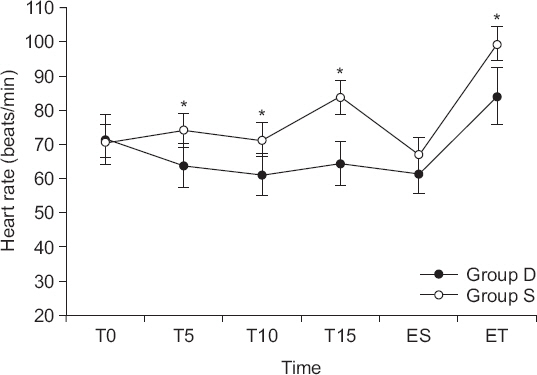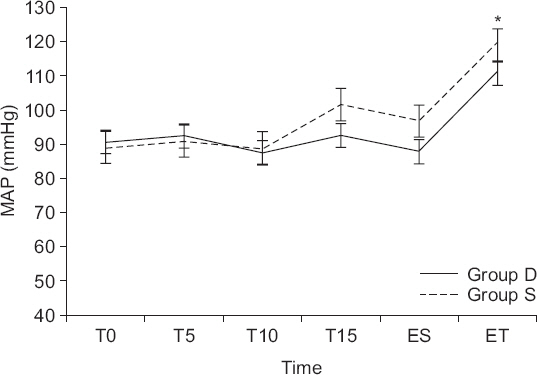Anesth Pain Med.
2018 Jan;13(1):23-29. 10.17085/apm.2018.13.1.23.
Pre-anesthetic sedative effect of dexmedetomidine in laparoscopic cholecystectomy performed under general anesthesia
- Affiliations
-
- 1Department of Anesthesiology and Pain Medicine, Eulji University Hospital, Daejeon, Korea. ryu4912@naver.com
- 2Department of Surgery, Eulji University Hospital, Daejeon, Korea.
- KMID: 2436051
- DOI: http://doi.org/10.17085/apm.2018.13.1.23
Abstract
- BACKGROUND
This study evaluated the effects of pre-anesthetic administration of dexmedetomidine on sedative, cardiovascular, and recovery parameters.
METHODS
This was a prospective, randomized, double-blind, placebo-controlled study. We selected 60 patients who were scheduled to undergo laparoscopic cholecystectomy. They were randomly divided into two groups and received 0.5 µg/kg of dexmedetomidine (group D) or normal saline (group S) over 10 minutes before induction of anesthesia. The Ramsay sedation scale (RSS) score and bispectral index (BIS) were recorded after completion of the dexmedetomidine infusion. Mean arterial pressure (MAP), heart rate (HR), peripheral pulse oximetry, cardiac output (CO), and systemic vascular resistance (SVR) were recorded. The modified Aldrete recovery score (MARS) was recorded in the recovery room.
RESULTS
After completion of the dexmedetomidine infusion, BIS reduction was less than 20% (97.1 ± 2.4, 83.8 ± 4.8; P < 0.001), but RSS-rated sedation was appropriate (P < 0.001). HR was lowest at the end of the dexmedetomidine infusion and there was a significant difference between groups (P < 0.001); however, MAP was not significantly different between groups (P = 0.139). CO was lowest and SVR was highest at the end of the dexmedetomidine infusion. There was no significant difference in MARS values between groups (P = 0.190).
CONCLUSIONS
A pre-anesthetic dexmedetomidine (0.5 µg/kg) provided appropriate sedation without serious changes in cardiovascular parameters or a prolonged recovery time.
MeSH Terms
Figure
Reference
-
1. Haugen AS, Eide GE, Olsen MV, Haukeland B, Remme AR, Wahl AK. Anxiety in the operating theatre: a study of frequency and environmental impact in patients having local, plexus or regional anaesthesia. J Clin Nurs. 2009; 18:2301–10. DOI: 10.1111/j.1365-2702.2009.02792.x. PMID: 19583663.2. Czeisler CA, Ede MC, Regestein QR, Kisch ES, Fang VS, Ehrlich EN. Episodic 24-hour cortisol secretory patterns in patients awaiting elective cardiac surgery. J Clin Endocrinol Metab. 1976; 42:273–83. DOI: 10.1210/jcem-42-2-273. PMID: 1262431.3. Basar H, Akpinar S, Doganci N, Buyukkocak U, Kaymak C, Sert O, et al. The effects of preanesthetic, single-dose dexmedetomidine on induction, hemodynamic, and cardiovascular parameters. J Clin Anesth. 2008; 20:431–6. DOI: 10.1016/j.jclinane.2008.04.007. PMID: 18929283.4. Kamibayashi T, Maze M. Clinical uses of alpha2 -adrenergic agonists. Anesthesiology. 2000; 93:1345–9. DOI: 10.1097/00000542-200011000-00030. PMID: 11046225.5. Bhana N, Goa KL, McClellan KJ. Dexmedetomidine. Drugs. 2000; 59:263–8. discussion 269-70. DOI: 10.2165/00003495-200059020-00012. PMID: 10730549.6. El-Shmaa NS, El-Baradey GF. The efficacy of labetalol vs dexmedetomidine for attenuation of hemodynamic stress response to laryngoscopy and endotracheal intubation. J Clin Anesth. 2016; 31:267–73. DOI: 10.1016/j.jclinane.2016.01.037. PMID: 27185725.7. Bekker A, Sturaitis MK. Dexmedetomidine for neurological surgery. Neurosurgery. 2005; 57(1 Suppl):1–10. discussion 1-10. DOI: 10.1227/01.NEU.0000163476.42034.A1.8. Aantaa R. Assessment of the sedative effects of dexmedetomidine, an alpha 2-adrenoceptor agonist, with analysis of saccadic eye movements. Pharmacol Toxicol. 1991; 68:394–8. DOI: 10.1111/j.1600-0773.1991.tb01259.x. PMID: 1682907.9. Mondello E, Siliotti R, Noto G, Cuzzocrea E, Scollo G, Trimarchi G, et al. Bispectral Index in ICU: correlation with Ramsay Score on assessment of sedation level. J Clin Monit Comput. 2002; 17:271–7. DOI: 10.1023/A:1021250320103. PMID: 12546259.10. Arcangeli A, D’Alò C, Gaspari R. Dexmedetomidine use in general anaesthesia. Curr Drug Targets. 2009; 10:687–95. DOI: 10.2174/138945009788982423. PMID: 19702517.11. Ebert TJ, Hall JE, Barney JA, Uhrich TD, Colinco MD. The effects of increasing plasma concentrations of dexmedetomidine in humans. Anesthesiology. 2000; 93:382–94. DOI: 10.1097/00000542-200008000-00016. PMID: 10910487.12. Aantaa R, Kanto J, Scheinin M, Kallio A, Scheinin H. Dexmedetomidine, an alpha 2-adrenoceptor agonist, reduces anesthetic requirements for patients undergoing minor gynecologic surgery. Anesthesiology. 1990; 73:230–5. DOI: 10.1097/00000542-199008000-00007. PMID: 1974394.13. Dutta S, Karol MD, Cohen T, Jones RM, Mant T. Effect of dexmedetomidine on propofol requirements in healthy subjects. J Pharm Sci. 2001; 90:172–81. DOI: 10.1002/1520-6017(200102)90:2<172::AID-JPS8>3.0.CO;2-J.14. Zhao XN, Ran JH, Bajracharya AR, Ma MY. Effect of different doses of dexmedetomidine on median effective concentration of propofol for anesthesia induction: a randomized controlled trial. Eur Rev Med Pharmacol Sci. 2016; 20:3134–43. PMID: 27460746.15. Gertler R, Brown HC, Mitchell DH, Silvius EN. Dexmedetomidine: a novel sedative-analgesic agent. Proc (Bayl Univ Med Cent). 2001; 14:13–21. DOI: 10.1080/08998280.2001.11927725.16. Langer SZ. Presynaptic regulation of the release of catecholamines. Pharmacol Rev. 1980; 32:337–62. PMID: 6267618.17. Lee CW, Kim M. Effects of preanesthetic dexmedetomidine on hemodynamic responses to endotracheal intubation in elderly patients undergoing treatment for hypertension: a randomized, double-blinded trial. Korean J Anesthesiol. 2017; 70:39–45. DOI: 10.4097/kjae.2017.70.1.39. PMID: 28184265. PMCID: PMC5296386.18. Noh C, Ko YK, Kim YH, Lim CS, Chung WS, Lee JY, et al. Effect of dexmedetomidine on endotracheal intubating conditions during endotracheal intubation without neuromuscular blocker following propofol/remifentanil. Anesth Pain Med. 2017; 12:56–61. DOI: 10.17085/apm.2017.12.1.56.19. Bloor BC, Ward DS, Belleville JP, Maze M. Effects of intravenous dexmedetomidine in humans. II. Hemodynamic changes. Anesthesiology. 1992; 77:1134–42. DOI: 10.1097/00000542-199212000-00014. PMID: 1361311.20. Goyal R. Dexmedetomidine: the game changer or a team player? J Anaesthesiol Clin Pharmacol. 2016; 32:144–5. DOI: 10.4103/0970-9185.182084. PMID: 27275039. PMCID: PMC4874064.21. Ahn EJ, Park JH, Kim HJ, Kim KW, Choi HR, Bang SR. Anticholinergic premedication to prevent bradycardia in combined spinal anesthesia and dexmedetomidine sedation: a randomized, double-blind, placebo-controlled study. J Clin Anesth. 2016; 35:13–9. DOI: 10.1016/j.jclinane.2016.07.012. PMID: 27871510.22. Kallio A, Scheinin M, Koulu M, Ponkilainen R, Ruskoaho H, Viinamäki O, et al. Effects of dexmedetomidine, a selective alpha 2-adrenoceptor agonist, on hemodynamic control mechanisms. Clin Pharmacol Ther. 1989; 46:33–42. DOI: 10.1038/clpt.1989.103. PMID: 2568211.23. Khan ZP, Ferguson CN, Jones RM. Alpha-2 and imidazoline receptor agonists. Their pharmacology and therapeutic role. Anaesthesia. 1999; 54:146–65. DOI: 10.1046/j.1365-2044.1999.00659.x. PMID: 10215710.24. Ishii H, Kohno T, Yamakura T, Ikoma M, Baba H. Action of dexmedetomidine on the substantia gelatinosa neurons of the rat spinal cord. Eur J Neurosci. 2008; 27:3182–90. DOI: 10.1111/j.1460-9568.2008.06260.x. PMID: 18554299. PMCID: PMC2658019.25. Bajwa SJ, Kaur J, Singh A, Parmar S, Singh G, Kulshrestha A, et al. Attenuation of pressor response and dose sparing of opioids and anaesthetics with pre-operative dexmedetomidine. Indian J Anaesth. 2012; 56:123–8. DOI: 10.4103/0019-5049.96303. PMID: 22701201. PMCID: PMC3371485.
- Full Text Links
- Actions
-
Cited
- CITED
-
- Close
- Share
- Similar articles
-
- General anesthesia for laparoscopic cholecystectomy in a patient with Kennedy's disease: A case report
- The Effect of Anesthetic Technique on White Blood Cell Response to Surgery in Patients Who Underwent Laparoscopic Cholecystectomy and Cesarian Section
- Preoperative dexmedetomidine and intraoperative bradycardia in laparoscopic cholecystectomy: a meta-analysis with trial sequential analysis
- Does dexmedetomidine reduce postoperative pain after laparoscopic cholecystectomy with multimodal analgesia?
- Effects of preanesthetic single administration of dexmedetomidine on the remifentanil and propofol requirement during laparoscopic cholecystectomy




